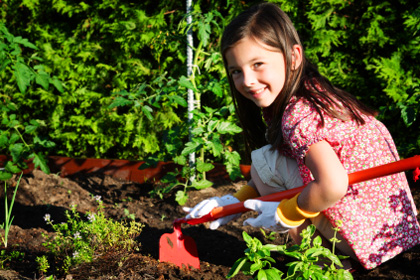 In the Northwest, it’s fairly common to see chickens clucking away happily in backyard coops, or to hear the term “urban farming” tossed around by friends and neighbors. More families are taking a back-to-the-basics approach when it comes to living simply — and they’re realizing that this DIY lifestyle has much to offer their children.
In the Northwest, it’s fairly common to see chickens clucking away happily in backyard coops, or to hear the term “urban farming” tossed around by friends and neighbors. More families are taking a back-to-the-basics approach when it comes to living simply — and they’re realizing that this DIY lifestyle has much to offer their children.
In her book, Your Farm in the City, Lisa Taylor of the gardening organization Seattle Tilth defines urban farming as “resourceful food gardening in a city setting,” and describes “farmers” as those who are “nobly growing food for themselves.”
Add in the fact that families want more control over what they eat, are trying to save money, be eco-friendly and connect their kids with nature, and it starts to make sense why urban farms are sprouting up in all corners of the city and show no sign of stopping.
In the past decade alone, Seattle Tilth has grown from offering two chicken workshops to 17, with an average of 20 attendees at each class. Its chicken coop tour, which once hosted 100 guests, now boasts 800. What’s more, Seattle’s Garden Hotline jumped from receiving 300 calls in 2000 to 992 in 2011.
To keep up with the interest in urban farming over the past five years, Seattle Tilth has added a new animal each year to its urban livestock classes. The classes now include chickens, goats, honeybees, ducks and rabbits.
With years of experience as a Seattle Tilth program manager for children’s education and as a home gardener, Taylor offers this advice for families looking to join the green trend: “Most urban farms don’t happen in one season. Be realistic about your time and know-how,” she says. “Start slow and then add more features or garden spaces. This way, tending your garden and farm becomes part of your lifestyle.”
Annette Cottrell, coauthor of The Urban Farm Handbook, echoes this notion. Urban farming can be as easy as shopping locally and having a vegetable garden, or as complex as keeping chickens and bees, she says. “Start with a container or small garden and local, seasonal fare — if it inspires you to do more, then go for it.”
Urban farming in a bad economy
For Seattle mother Traci Fontyn, urban farming offered a simple solution to the recession. “We began to assess our lifestyle and find ways to save money,” she says. “In came coupon clipping, planting a garden to save on produce cost, preserving food and getting a small flock of hens.”
Before long, the Fontyns’ new routine became less about money and more about lifestyle. “It feels good feeding your family nutritious food that you actually grow,” she says. “It has also brought our family together. We enjoy being outside in our yard during the summer, tending to our garden and our animals.”
Claiming that they “caught the bug” after tackling chickens, the Fontyn family now includes goats, chickens, an organic garden and a bee colony. “There is an educational value as well as value in the memories you are creating together as a family,” she says. “My son could read about this in a book instead of experiencing it, but that lacks the value of a precious memory and real life experience.”
Urban farming's benefits for teens
Taylor and Cottrell note that urban farming’s benefits can be especially inspiring for teens. “They’re seeking opportunities to populate the adult world and take on more advanced roles,” Taylor says. “Working in the garden and other big projects that require detail and finesse are great for that.”
Taylor recommends giving teens hands-on chores that will help them in the future, including using real tools or teaching them how to maintain equipment, such as wheelbarrows.
Urban farming can also teach teens about food consciousness and healthy eating habits, Cottrell says. “By getting them vested in their food — from choosing seeds to choosing chicks — they learn how their choices affect the planet and their bodies. They learn what good food tastes like and they become connected with it.”
Taylor’s 12-year-old son, Alwyn, loves preparing garden-fresh meals; his favorite dishes include garden burritos wrapped with sorrel leaves and massaged-kale salad. “Growing your own food can be a real eye-opening experience,” Taylor explains. “Many teens have no experience with whole food. What they eat comes from a store shelf, often in a package.”
Changing the urban landscape
If you ask 17-year-old Nina Finley about her 300-square-meter Seattle farm, she’ll mention the gorgeous view of the downtown skyline; how she can hear the rumble of nearby traffic; her show rabbit, Coalslaw, her five chickens and three ducks, of course; and how this backyard plot has been a place of refuge for her for nearly a decade.
While attending the county fair at age 9, Finley realized she wanted to be a farmer. “The instant I walked into the 4-H club’s livestock barn, I was home,” she says. Finley didn’t waste time reaching for her goals — she began drawing blueprints for her future farm, reading books about caring for farm animals and joined the Snohomish 4-H club, Wild ’n’ Woolies.
In 2011, Finley and her mother founded their own urban farming 4-H club, Cooped Up in Seattle. Celebrating its first anniversary this year, the club features 30 regular members (ages 5–19), with monthly meetings, community service options, its own poultry show and much more.
“4-H helps kids develop life skills by tapping into the energy and excitement they feel for their projects,” Finley says. “We learn how to make cheese, preserve vegetables; kids give public presentations or run for a club office and lead their peers.”
Today, Finley has fine-tuned her career aspirations. She’s applying to colleges that specialize in animal science and veterinary programs for large animals. “I couldn’t help but think, I could be working with large animals for a living! I could influence industrial agriculture, help cure mastitis or be educating subsistence through Heifer International. I realized how much sense a veterinary degree would make for me.”
Jen Betterley, ParentMap’s web editor, is excited to add two baby chicks to her own urban farm this year.
7 Great Ways to Get Teens Into Urban Farming
1. Plant a garden filled with herbs, salad plants and flowers with your teen, then harvest what you grow.
2. Involve teens in planning what you will grow in the garden or what breeds of animal you will raise.
3. Involve teens in more difficult jobs such as pruning, picking out seedlings or using power tools to build a worm bin or chicken coop.
4. Invite teens to cook a dish using food from the garden.
5. Join a Community Shared Agriculture (CSA) group and participate in farm activities.
6. Volunteer with your teen for a work party in a school or community garden.
7. Shop at a farmers market or farm stand; try new vegetables and fruit.
Compliments of Seattle Tilth's Lisa Taylor
Urban Gardening Resources for Kids and Families
Urban Farming Programs for kids:
Seattle Tilth. Teens can become junior camp counselors in the summer; classes for all ages are offered year-round.
Teens in Public Service (TIPS). Paid summer internships for teens; gardening/farming opportunities available.
Cooped Up in Seattle. Year-round activities, shows, and meetings; open to kids ages 5-19 for a $10 membership.
Gardening, feed, and supplies:
Portage Bay Grange Feed and Mercantile
Seattle Farm Co-op
Swanson’s Nursery
City People’s Garden Store
Urban farming services:
Seattle Urban Farming Company. Garden installation, maintenance, landscaping and more.
Kippen House. Seattle-made modern chicken coops with roof-top gardens.
The Urban Chicken. Poultry and livestock care service.
Ballard Bee Company. Apiary services.
Garden Mentors. Edible gardening instruction, planning and design.











